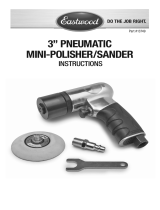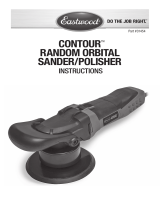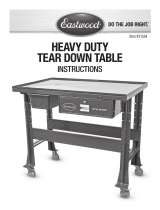Page is loading ...

DISC/BELT SANDER
INSTRUCTIONS
Part #13660Q

2 Eastwood Technical Assistance: 800.544.5118 >> techelp@eastwood.com
WARNINGS
• This tool has high-speed, highly abrasive surfaces which can quickly cause severe injury. Keep fi ngers and hands away from moving parts
when operating.
• Wear thick, well-fi tting work gloves, and keep loose clothing, sleeves, cords, jewelry and hair away from moving parts.
• Wear appropriate eye protection. Metal particles and dust can be ejected during the grinding/sanding process.
• Wear appropriate respiratory protection. Hazardous dust is generated during the grinding/sanding process.
• Frequently inspect belt and disc condition. If tears or holes develop, discontinue tool use immediately and replace damaged disc or belt.
INCLUDES
• (1) Disc/Belt Assembly
• (1) Belt Sander Tool Rest/Stop Fence with Screws & Washers
• (1) Disc Sander Adjustable Work Surface/Miter Plate and Lock-Down Knob
• (1) Disc Sander Miter Gauge and Fence
• (1) 6mm Hex Key
SPECIFICATIONS
• 120 VAC/60Hz, 4.3 Amps
• 1/2 HP, 3420 RPM
• Belt : 4” x 36”, 80-grit
• Disc: 6” pressure-sensitive adhesive-backed, 80-grit
ASSEMBLY
• Attach the Stop Fence/Tool Rest to the Belt Sander assembly with the two 6mm socket
head cap screws and washers included. Keep the bottom edge of the Fence/Rest ap-
prox. 0.063” [1.5mm] from the belt and tighten screws securely.
NOTE: Fence/Rest should not contact sanding belt. Check for contact with belt and
re-adjust if necessary (Fig. 1).
• Attach the Adjustable Work Surface/Miter Plate to the cast housing by placing the locat-
ing pin into the hole and securing with the yellow Lock-Down Knob.
NOTE: Work Surface/Miter Plate should not contact sanding disc. Check for contact
with disc and re-adjust if necessary (Fig. 2).
SET-UP
• Using suitable lag bolts or through bolts and nuts (not included), securely bolt the hous-
ing fl anges to a secure work surface to prevent tool movement while
in use.
• The Belt Sander feature position is adjustable from horizontal to 90° vertical.
To adjust: Loosen 6mm socket head cap screw on Belt Sander Pivot Clamp
with 6mm wrench included, choose your preferred working position for the
Belt Sander, then tighten screw securely to lock it in position (Fig. 3).
NOTE: Be certain the Belt Sander Assembly is securely clamped. Severe
personal injury could occur if Belt Sander Assembly position slips during use.
The EASTWOOD 36” BELT & 6” DISC SANDER is designed for rugged reliability and ease of use. The positionable belt drive assembly provides a full 90° of adjustment from
horizontal to vertical, and features a secure stop fence/tool rest for safety and convenience. The 6” disc sander features an angle-adjustable
work surface and sliding miter gauge/fence to allow grinding to precise angles with one convenient bench-mount tool.
FIG. 1
FIG. 1
FIG. 3
FIG. 3
FIG. 2
FIG. 2

To order parts and supplies: 800.345.1178 >> eastwood.com 3
OPERATION
• Plug power cord into a 120 VAC outlet and move power switch up to the
“ON” position.
• When using the Belt Sanding feature, allow your workpiece to gently rest against the
Stop Fence/Tool Rest and move it from side to side as the belt is moving (Fig. 4).
WARNING: Do not keep your workpiece in one place while sanding, and
do not push your workpiece into the belt since this will overheat the belt, causing
premature wear, failure and possibly personal injury.
• When using the Disc Sanding feature, allow your workpiece to gently rest on the Adjust-
able Work Surface/Miter Plate and gently press it against the disc as it rotates; do not
force it into the disc (Fig. 5).
The Adjustable Work Surface angle is adjustable vertically from 0° to 45°, and the Miter
Plate Fence is angle-adjustable horizontally through a full 120° to allow precise angle
grinding of tool surfaces.
BELT TRACKING ADJUSTMENT
For ideal operation and true tracking, both the Belt Drive and the Idler Drums should be parallel
to one another. With tool use, occasional adjustment may be required.
Follow steps 1 through 7 below for belt tracking adjustment.
CAUTION: Unplug tool before beginning belt tracking adjustment or severe personal injury
could result if motor should start during this procedure.
1. Loosen belt tension by pulling out the grey Belt Tension Lever (nested into the front of
the Belt Sander Assembly) until it stops. It will remain in this position (Fig. 6).
2. Center the belt on both the Belt Drive and Idler Drums by sliding it in or
out as needed.
3. Snap the Belt Tension Lever back into its place on the Belt Sander Assembly.
4. Roll the belt by hand and observe whether the belt is skewing to one side or another or
making contact with the frame of the Belt Sander.
5. If skewing right – decrease tension on tracking by turning the Yellow Tracking Knob up
or “toward” the Belt Sander working surface. This will force the belt to track towards
the left or “rear” of the tool (Fig. 7).
6. If skewing left – increase tension on tracking by turning Yellow Tracking Knob down or
“away” from the Belt Sander working surface. This will force the belt to track towards
the right or “front” of the tool (Fig. 7).
7. It may be necessary to repeat steps 1 through 4 several times until even belt tracking is
achieved.
FIG. 4
FIG. 4
FIG. 5
FIG. 5
FIG. 6
FIG. 6
FIG. 7
FIG. 7

© Copyright 2012 Easthill Group, Inc. Instruction part #13660Q Rev. 5/12
If you have any questions about the use of this product, please contact
The Eastwood Technical Assistance Service Department: 800.544.5118 >> email: techelp@eastwood.com
The Eastwood Company 263 Shoemaker Road, Pottstown, PA 19464, USA
US and Canada: 800.345.1178 outside US: 610.718.8335
Fax: 610.323.6268 eastwood.com
BELT REPLACEMENT
CAUTION: Unplug tool before beginning belt replacement or severe personal injury could result
if motor should start during this procedure. Always use an Eastwood-
approved 4” x 36” sanding belt to insure safe operation.
1. Loosen belt tension by pulling out the grey Belt Tension Lever (nested into the front of
the Belt Sander Assembly) until it stops. It will remain in this position.
2. Pull worn belt off the Belt Sander Assembly by pulling it toward the right or “front” of
the tool. (Fig. 8).
3. Place the new belt onto the Belt Sander Assembly by sliding it over the Belt Drive and
Idler Drums and centering it.
4. Snap the Belt Tension Lever back into its place on the Belt Sander Assembly.
5. Roll the belt by hand and observe whether the belt is skewing to one side or another or
making contact with the frame of the Belt Sander.
6. If the belt is skewing to one side or another after replacement, follow the Belt Tracking
Adjustment procedure outlined previously.
DISC REPLACEMENT
CAUTION: Unplug tool before beginning disc replacement or severe personal injury could result
if motor should start during this procedure. Always use an Eastwood-approved 6” PSA sanding
disc to insure safe operation.
1. Remove the Adjustable Work Surface/Miter Plate by loosening and removing
the Yellow Locking Knob.
2. Peel away the worn sanding disc from the backing plate (Fig. 9).
3. Clean any adhesive residue, grit or dirt from the backing disc.
4. Peel backing paper from the new sanding disc, center over the backing disc, and press
into place. Be sure all surfaces of disc are adhering and no bubbles or wrinkles are
present.
TOOL MAINTENANCE
• Inspect sanding belt and disc for damage before each use, and replace if worn or torn.
• Keep all areas of the tool clean, particularly those surfaces that contact sanding belt and disc. Dirt and metal chips can cause uneven sanding
and inaccurate grinding.
• Store in a clean and dry environment when not in use. Coat all machined surfaces with a light lubricant fi lm of oil or suitable protectant to
prevent rust formation.
AVAILABLE SANDING BELTS AND DISCS
#13660A 4” x 36” 80-Grit Sanding Belts, (2-pack)
#13660B 4” x 36” 120-Grit Sanding Belts, (2-pack)
#13660C 4” x 36” 240-Grit Sanding Belts, (2-pack)
#13660D 6” 80-Grit, PSA Sanding Discs, (5-pack)
#13660E 6” 120-Grit, PSA Sanding Discs, (5-pack)
#13660F 6” 240-Grit, PSA Sanding Discs, (5-pack)
FIG. 8
FIG. 8
FIG. 9
FIG. 9
/









